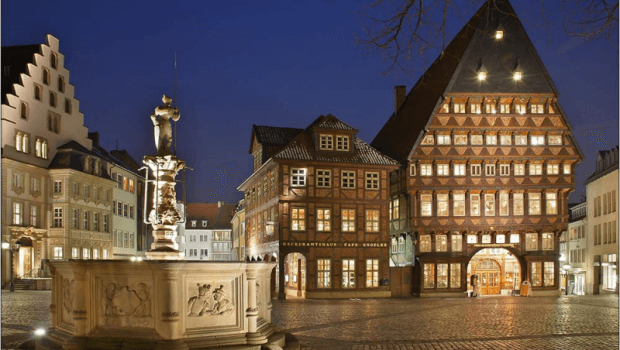
Hildesheim: Where History Marries Culture
One of the biggest cities in the northern part of Germany and the place of a multitude of churches, the city of Hildesheim is a historically, economically and culturally important center in Germany. Let’s unearth all we can about this city!
Location:
With 52°09’ N and 09°57’ E as its coordinates, Hildesheim City is situated in Hildesheim district, a Landkreis, 30 kilometers to the southeast of Hanover City on the banks of the River Innerste, in the state of Lower Saxony, Germany.
Weather:
The average temperature in Hildesheim in July and August reaches 24 degrees Celsius, making them the warmest months of the year. During December, January, and February, the temperature drops to an average low of -1 degree Celsius. March, July, August, and December receive the maximum amount of rainfall on an average.
History:
In 815, Hildesheim City came to be the seat of the Bishopric of Hildesheim, followed by the granting of rights by King Otto III to the community around the Hildesheim Cathedral in 983. 1249 saw Hildesheim achieve city status and become one of the largest cities in Northern Germany. The city was ruled by the clergy for four centuries, after which the present city hall was built in 1268. A part of the Hanseatic League in 1367, most of the citizens of Hildesheim turned Lutheran in 1542 after a prolonged dispute between them and their bishop, though the cathedral along with a couple of other structures remained Catholic. Following the Napoleonic Wars (1803-1815), the Kingdom of Hanover made Hildesheim its part but was annexed by the Kingdom of Prussia in 1866. Prussian soldiers in 1868 discovered the Hildesheim Treasure, the biggest collection of Roman silver to have been found outside the boundaries of the Roman Empire.
The city of Hildesheim was bombed in 1945 towards the end of World War II, as a result of which, only 26% of the houses were intact, while the rest were either destroyed or severely damaged. Soon after this, most of the churches were reconstructed in their original styles, two of them being designated as UNESCO World Heritage Sites in 1985. The Day of Lower Saxony was celebrated in Hildesheim in 2015 to mark the 1200th anniversary of the city.
The City:
Hildesheim covers a total area of 92.96 square kilometers inhabited by around 100,000 people, of whom 38.3% are Protestants under the Lutheran State Church of Hanover, and 28.5% are Roman Catholics. About 33% of the citizens either adhere to Salafism and Islam or follow no religion at all. The largest minority groups in Hildesheim are from Turkey, Poland, Serbia and Italy.
Around the church of St. Andreas in Hildesheim is laid out what was once regarded as one of the most charming marketplaces in the world – the Historic Market Place or the Marktplatz. The city has several half-timbered buildings in and around the Historic Market Place. The Butchers’ Guild Hall or Knochenhauer-Amtshaus, made of oak wood in a Gothic style, is one such impressive specimen, others being the Wedekindhaus, which was the first half-timbered building in the Marktplatz to be rebuilt, and the Weavers’ Guild Hall or Wollenwebergildehaus at the corner of the Ropemaker Street. You can also spot half-timbered houses in streets like Gelber Stern, Brühl, Knollenstraβe, and Lappenburg, around the Kehrwieder Tower and St. Godehard. The façades of some of these houses are decorated with artistic wood carvings, as illustrated by the Waffenschmiedehaus or the house of the weapon smith at Gelber Stern Street, and the Wernersches Haus in Godehardsplatz.
Most of the structures around the Marktplatz in Hildesheim display either Baroque or Gothic architectural designs. The Town Hall with its Tower “Lilie”, for instance, one of the oldest German city halls, was erected in the 13th century in Gothic fashion. The late-Gothic style can be detected in the patrician Temple House of the 14th century, in which the tourist information office is located today. You can make out the Baroque Lüntzelhaus, and the Rococo House with a rococo design. The Roland House represents a blend of Gothic and Baroque styles of architecture.
How to Get There:
An InterCity Express from Berlin to Frankfurt stops at Hildesheim. An alternative option would be to get on board, from Hanover, either a Regional Express (RE) or any one of two S-Bahn trains – S3 and S4. The A7 links Hildesheim to the Autobahn network, so it is possible to get there by car. If you want to reach the city by plane, you need to alight at the Hanover Airport and catch a train to Hildesheim, which would take an hour.
Once you reach Hildesheim, you can visit the interesting spots by taxi or by bus. The cost of a city bus ticket is 2.15 euros for adults and 1 euro for children. You can also explore the city by cycle or on foot.
Why Visit?
Hildesheim, one of the oldest cities in Northern Germany, is the headquarters of the Serbian Orthodox Diocese of Central Europe. The city has accommodated Bishops of Hildesheim St. Bernward and St. Godehard, the German African explorer Frederick Hornemann, noted author Petra Hartmann, German mathematician Adolf Hurwitz, Northern Ireland footballer Maik Taylor, actress Diane Kruger, and numerous other persons of renown. Apart from being home to the German electronics equipment manufacturer Blaupunkt, the city is a thriving economic hub with a number of significant multinational corporations such as Bosch, Coca-Cola, ThyssenKrupp, and Fairchild.
Besides, Hildesheim is the venue of one of the biggest events of dark alternative music in Germany and the most famous dark music festival in Europe – the M’era Luna. Held at Flugplatz Hildesheim-Drispenstedt every year in the second weekend of August, this event is attended by around 25,000 people from all over the world. On 13th and 14th August 2016, gothic and metal music lovers are going to enjoy performances put up by the likes of Diary of Dreams, Suicide Commando, Apocalyptica, the Sisters of Mercy, Zecromancer, VNV Nation, Gothminister, and much more!
At the Jazztime Festival presented annually by the Hildesheimer Allgemeine Zeitung, artists and bands from different countries entertain lovers of jazz, blues and country music in May or June. Every year from 24th November to 26th December, the Historical Market Place hosts the Christmas Market of Hildesheim with about 70 decorated stalls selling Christmas delicacies and crafts, a Christmas pyramid, and winter lights luring tourists daily from 10:00 am or 11:00 am till 8:00 pm. With the vintage car show titled “Technorama”, Hildesia City Festival, the Marienrode Monastery Concert, the French and the Italian markets, the Street Food caravan, the Magdalenenfest and many other events, Hildesheim welcomes you all!
Major Attractions:
- The Hildesheim Cathedral (Hildesheimer Dom) – Built in the 9th century, the Romanesque Cathedral of the Assumption of Mary was reconstructed soon after its almost complete destruction in 1945, leading to its place in the list of UNESCO World Heritage sites in 1985. It houses treasures such as the Bernward Doors of Romanesque or Ottonian bronze, the Romanesque Hezilo chandelier dating from the 11th century, and the oldest living rose in the world known as the “Thousand-year Rose.”
- Michael’s Church (Michaeliskirche) – An early-Romanesque Lutheran church built between 1010 and 1022, this UNESCO World Cultural Heritage site is one of the leading churches representing architecture from the early Christian period.
- The Roemer-und Pelizaeus-Museum –This museum displays not only exclusive Ancient Peruvian and Ancient Egyptian art but also Europe’s second largest collection of Chinese porcelain, together with drawings of and collections from local and natural history and archaeology. Permanent and temporary exhibitions are also hosted.
- Godehard- Constructed from 1133 and consecrated in 1172, this church was used as the cathedral of the Bishop of Hildesheim until 1960. Opposite this Romanesque Basilica minor, you can spot the half-timbered building of the Hospital of the Five Wounds, which dates back to 1770.
- The Kehrwieder Tower (Kehrwiederturm) – Of the medieval fortifications in Hildesheim, only the Kehrwiederturm, built in 1300, remains.
- Maurice’s Church (Mauritiuskirche) – The interior of this 11th-century Romanesque church is baroque. You can get an incredible view of Hildesheim from the forest behind Mauritiuskirche.
- The church of St. Andreas– With the tallest church steeple of 114.5 meters (376 feet) in Lower Saxony, this main Lutheran church in Hildesheim dates from the 12th Its top offers a beautiful view of the city of Hildesheim and the surrounding countryside.
- The Upended Sugarloaf (Der Umgestülpte Zuckerhut) – This historic half-timbered house opposite the church of St. Andreas dates back to 1509.
- The Church of the Holy Cross (Kreuzkirche) – Around 1079, this portion of the medieval fortifications was made into a church, and was reconstructed after the Second World War.
- The Imperial House (Kaiserhaus) – Situated in Hildesheim’s oldest street named the Alter Markt, Roman, Persian and Greek medallions, and statues adorn the façade of this Renaissance structure.
- The Church of St. Magdalena – Also positioned in the Alter Markt Street is the small Magdalenenkirche with huge lancet windows. Though it was built in a Romanesque style, to begin with, a Gothic design was given to it at the time of its reconstruction in 1456.
- Magdalenengarten – Close by St. Magdalena’s Church, you can find this 6-acre baroque park dating back to the 18th century and laid out with a rose museum, a rare species of wild tulips, a vineyard, and different varieties of rose bushes. This garden hosts the Magdalenenfest, an annual garden festival.
- Ice Age– From January to February, the middle of downtown Hildesheim is transformed into a winter landscape with an ice rink of 750 square meters, where you can compete with other visitors in ice skating acts. At the edge of the rink, the Winter Market invites you to have fun.
What Else is Around?
- Marienburg Castle (Schloss Marienburg)
- Bernward’s Church
- The St. Lamberti Church
- Sorsum
- Steuerwald Castle (Burg Steuerwald)
With several churches, many historical buildings, and countless events and festivals of different types, Hildesheim has these and much more up its sleeve for you. So go ahead and plan a trip with your family and friends and enjoy exploring this place. Hildesheim won’t disappoint you, we promise!
